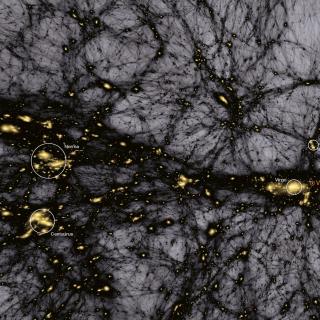Bibcode
Einasto, M.; Tago, Erik; Lietzen, H.; Park, Changbom; Heinämäki, Pekka; Saar, Enn; Song, Hyunmi; Liivamägi, Lauri Juhan; Einasto, Jaan
Referencia bibliográfica
Astronomy and Astrophysics, Volume 568, id.A46, 10 pp.
Fecha de publicación:
8
2014
Revista
Número de citas
28
Número de citas referidas
24
Descripción
Context. To understand the formation, evolution, and present-day
properties of the cosmic web we need to study it at low and high
redshifts. Aims: We trace the cosmic web at redshifts that range
from 1.0 ≤ z ≤ 1.8 by using the quasar (QSO) data from the SDSS
DR7 QSO catalogue. Methods: We apply a friend-of-friend algorithm
to the quasar and random catalogues to determine systems at a series of
linking length and analyse richness and sizes of these systems.
Results: At the linking lengths l ≤ 30 h-1 Mpc, the number
of quasar systems is larger than the number of systems detected in
random catalogues, and the systems themselves have smaller diameters
than random systems. The diameters of quasar systems are comparable to
the sizes of poor galaxy superclusters in the local Universe. The
richest quasar systems have four members. The mean space density of
quasar systems, ≈ 10-7 (h-1 Mpc)-3,
is close to the mean space density of local rich superclusters. At
intermediate linking lengths (40 ≤ l ≤ 70 h-1 Mpc), the
richness and length of quasar systems are similar to those derived from
random catalogues. Quasar system diameters are similar to the sizes of
rich superclusters and supercluster chains in the local Universe. The
percolating system, which penetrate the whole sample volume appears in a
quasar sample at a smaller linking length than in random samples (85
h-1 Mpc). At the linking length 70 h-1 Mpc, the
richest systems of quasars have diameters exceeding 500 h-1
Mpc. Quasar luminosities in systems are not correlated with the system
richness. Conclusions: Quasar system catalogues in our web pages
and at the Strasbourg Astronomical Data Center (CDS) serve as a database
for searching superclusters of galaxies and for tracing the cosmic web
at high redshifts.
Appendix A is available in electronic form at http://www.aanda.orgThe
catalogues are only available at the CDS via anonymous ftp to http://cdsarc.u-strasbg.fr
(ftp://130.79.128.5) or via http://cdsarc.u-strasbg.fr/viz-bin/qcat?J/A+A/568/A46
Proyectos relacionados

Cosmología con Trazadores de la Estructura a Gran Escala del Universo
El Fondo Cósmico de Microondas (FCM) contiene la información estadística de las semillas primigenias que han dado lugar a la formación de todas las estructuras en el Universo. Su contrapartida natural en el Universo local es la distribución de las galaxias que surgen como resultado del crecimiento gravitatorio de aquellas fluctuaciones de densidad
FRANCISCO SHU
KITAURA JOYANES